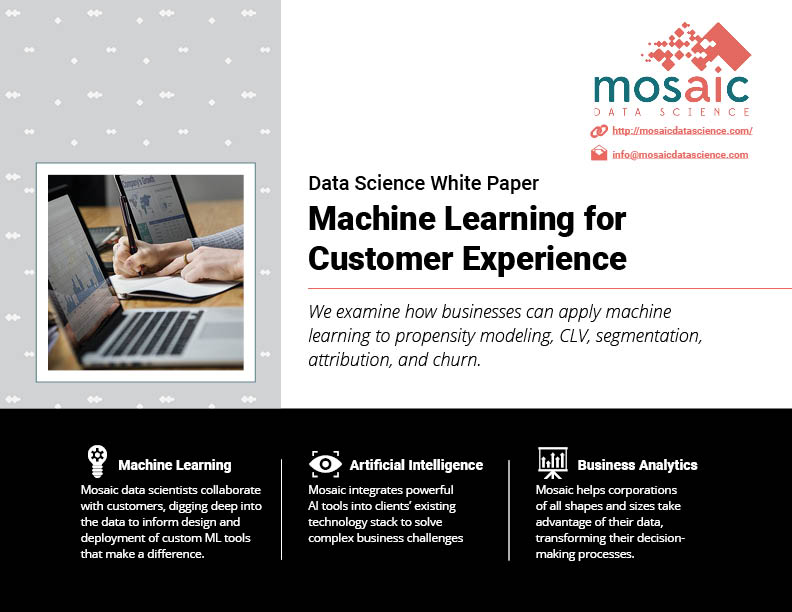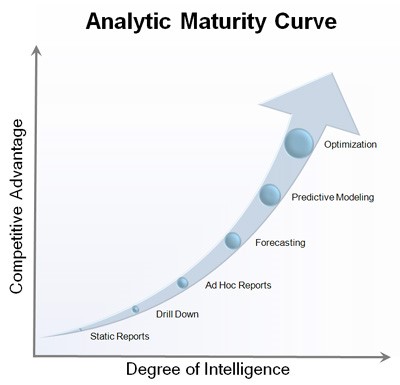Summary
We examine how businesses can apply machine learning to propensity modeling, CLV, segmentation, attribution, and churn.

Take Our Content to Go
Introduction
Using data to inform your marketing, sales, and customer experience decisions is increasingly essential for business success. If businesses fail to provide personalized customer experiences, they face the loss of brand equity, market share and — most importantly — loyal customers. Today’s consumers have more access to information than ever before. Information like where to shop, what to buy, and how much to pay are all at consumers’ fingertips. Companies that embrace new data streams and model them with internal data sources like historical sales and demand data will provide enhanced, more focused experiences, keeping and growing their valued customer-base.
Predicting customer behavior is increasingly critical. The more a business understands about consumer buying cycle and habits, the more ways it can influence future behavior with relevant targeted advertisements, content, promotions or messaging.
Moving from descriptive, rear-view looking customer analytics to predictive and prescriptive views of the customer requires complex change (see Figure 1.1). Marketing, sales, and customer service departments need to know how to locate data and prepare it for analysis, which algorithms can solve their business questions, and how outputs will be utilized in a business decision-making setting.

Here we explore how a machine learning consulting firm like Mosaic Data Science or any professional analytics practitioner can apply data science modeling and advanced analytics to solve customer experience problems. After describing use case selection and the modeling of customer behavior, we address four practical areas for optimizing outputs. In doing so we will refer to customer behavior modeling as an all-encompassing term for modeling tendencies, web-behavior, transactional history, sentiment, survey response, etc. Because individuals make buying decisions and understanding their behavior can lead to game-changing insights for your business, the concepts detailed here are applicable to both B2B and B2C organizations.
Before building predictive customer behavior models it is important to know what questions you are trying to answer. In short, make sure the business users and decision makers are on the same page as the analytics team.
Modeling Customer Behavior | Machine Learning for Customer Experience
Once a business has identified a feasible use case for advanced analytics and a collaboration schedule has been set, our data science team undertakes an investigation of consumer behavior and demand patterns. Exploratory analyses are conducted on available data sources. Both data quality and completeness as well as correlation analyses of relevant demographic and behavioral factors that influence human decision making are examined. Stakeholders are involved to incorporate subject matter expertise into the analysis and to ensure known factors are covered.
An analytics team should utilize the insights from this exploratory analysis to drive feature engineering and an agile, iterative approach to model development activities. Data integration and modeling workflow are implemented in an analytics platform to allow for dynamic comparison of multiple modeling approaches.
A focus on machine learning models for classification such as logistic regression, random forests, naïve Bayes classifiers, or support vector machines (SVMs) provides maximum benefit. Value is placed on model simplicity; complexity increases only with sufficient performance improvement. Model interpretability — the ability for subject matter experts to understand the internal model logic – incorporates the objectives of model performance and interpretability based on that input.
Next the machine learning team should select model performance metrics for the comparison that best align with the business objectives related to the model outputs. Typical customer behavior metrics include accuracy, specificity/sensitivity, and receiver operating characteristic (ROC) metrics such as area under curve (AUC). By using more targeted metrics, models can be selected and optimized based on fitness for the ultimate business objectives for which the models are being used. A performance assessment employs well accepted methods such as cross-validation to ensure that performance metrics are representative of expected model performance on new data. Models are selected and optimized independently using a common workflow architecture and data integration stream. Automated analysis outputs that allow stakeholders to quickly assess model performance following a data refresh or changes to the underlying model are added into the workflow for each model.
Four ML Use Cases that Matter to Sales and Marketing Teams
Once agreed-upon consumer behavior models have been built, the analytics team should input selected model features for different analytics use cases such as customer lifetime value, customer segmentation, attribution, and customer churn. Each of these features provides invaluable insights to stakeholders about the composition of their customer base.
- Customer Lifetime Value (CLV): Definition and modeling of one or more metrics for measuring and tracking CLV. Utilization of forward-looking CLV models to project trends and changes in the CLV of the customer base in support of improved revenue streams.
- Customer Segmentation: Creation of customer segments useful to understanding patterns in customer spending based on a gross merchandise value (GMV) statistic. Analysis of segments to understand growth, change, and how customers in low-value segments can be influenced to increase their site spend.
- Attribution: Analysis and modeling of key growth targets, metrics, and drivers for insight into the contribution of each media/marketing/advertising campaign. Ownership assignment of metrics and measurement of function-level impact in more relevant and actionable ways.
- Customer Churn: Analysis and modeling of customer churn to recognize drivers and leading indicators of churn. Development of second-order metrics to track churn drivers and advance retention activities.
Customer Lifetime Value Machine Learning Plan
CLV measures can help guide and prioritize promotional and customer service decisions. Mosaic Data Science applies CLV metrics using rear-looking customer analytics describing current values, as well as predictive and prescriptive views, projecting CLV over time. In the following points we highlight an example of a successful modeling plan.
- Metric definition: Evaluate and compare multiple CLV metrics to determine utility
- Compare over multiple windows and varying discount factors
- Select and model one or more of candidate CLV metrics for reporting and analysis
- Analysis: Analyze current customer base using selected CLV metrics
- Generate distribution of CLV across customer base
- Analyze trends in distribution over time
- Identify natural clusters within the distribution
- Forward-looking Modeling: Build and compare multiple CLV models to predict forward-looking CLV for individual customers and customer segments
- Leverage insights from GMV and churn analyses
- Use multiple modeling approaches
- Trend-based forecast models
- Regression models
- Conditional survival models
- Cluster-based models
Customer Segmentation Machine Learning Plan
Developing a segmentation methodology can undeniably enhance a company’s understanding of customer behavior. This enables facility with respect to total spend, the identification of trends in the changing makeup of the customer base, and insights into how the company may be able to target low-spend customer segments to promote conversion into a higher-spending cluster. Below you can see an example of a successful plan.
- Develop and analyze distributions of customer GMV
- Evaluate over various spending windows
- Analyze trends in distribution over time
- Identify natural clusters within the distribution
- Quantify mobility of customers over time – how often individual customers move from high to low and from low to high spending quantiles
- Identify any “typical” customer lifecycles with respect to GMV
- Analyze customer demographics with respect to GMV
- Identify demographic variables that correlate with GMV
- Apply multiple clustering techniques (k-means, hierarchical, tree-based, etc.) to combined demographic and GMV variables to identify meaningful customer clusters
- Identify customer segments or characteristics of customers with high potential for increasing GMV
- Leverage mobility and lifecycle analyses to identify customers already on a growth path
- Leverage cluster analyses to identify customers in low GMV quantiles with traits similar to those in high GMV segments
Attribution Machine Learning Plan
Establishing attribution methodologies that can measure the individual contribution of each functional group to key growth metrics is necessary to allocate proper advertising spend. This can be an open-ended use case and sometimes requires close collaboration between analytic teams and stakeholders to generate customer experience models, build process maps, and perform root cause analyses. Project team members work together to develop new metrics from these analyses that can be appropriately assigned to a single function within the organization. They then implement new decomposition algorithms to quantify functional impacts on existing growth targets.
Customer Churn Machine Learning Plan
These types of modeling exercises can help a company better understand drivers of customer churn and identify attrition/retention trends within customer segments to better project spend and to support revenue targets. See below for a potential successful schedule of modeling activities.
- Analyze customer attrition rates
- Quantify overall attrition rates
- Quantify seasonal attrition patterns
- Quantify and compare attrition rates across customer segments
- Identify demographic and behavioral variables that correlate with churn rates
- Develop leading indicator metrics that correlate with high customer churn
- Build and compare multiple churn models to forecast attrition within individual customer segments
- Survival models
- Regression/classification models
Conclusion | Machine Learning for Customer Experience
An approach to these challenges is one a machine learning company like Mosaic Data Science frequently takes. Mosaic’s highly experienced and comprehensive scientific approach to the modeling of consumer behavior can enable high-impact customer experience decision-making. The complex transition from integrating data sources into a visualization platform to predicting and influencing customer behaviors is demanding. Once predictive analysis and insights have been identified, business stakeholders must integrate these insights into business and workflow processes, ensuring that changes and shifts in behavior are consistently monitored and updated. Mosaic Data Science enables businesses to aggressively attain success by retaining customers, increasing sell-through rates, acquiring new customers, achieving segmentation, and reaching objectives.
Embracing a machine learning for customer experience approach to decision-making allows sales and marketing departments to better understand their customers, helping them build and maintain a competitive edge in a fast-paced, data-dominated world. Mosaic Data Science defines and directs the future of customer experience decisions.


